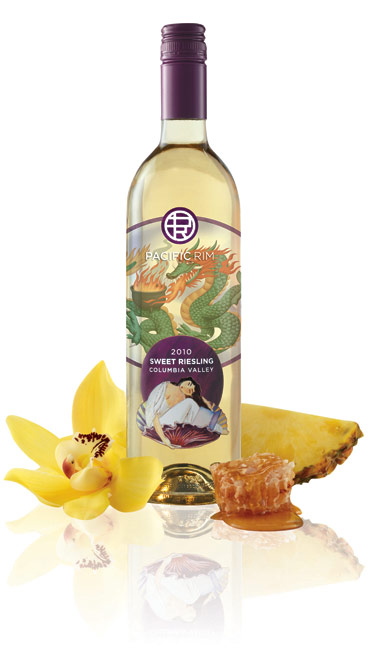Put a dragon in your Riesling
 Already we are into the Chinese New Year – and this year it is the year of the dragon! What a great opportunity to talk Sweet Riesling – our best-selling Riesling adorned with a Dragon carrying a cauldron of fire on the label.
Already we are into the Chinese New Year – and this year it is the year of the dragon! What a great opportunity to talk Sweet Riesling – our best-selling Riesling adorned with a Dragon carrying a cauldron of fire on the label.
THE STYLE - The wine came out of a vision, the vision of a great American Kabinett. Of course we could not reproduce that style exactly (Eastern Washington weather and soils are not the Mosel) and we had to tweak things a bit to make a good wine years after years (more on this learning experience later).
THE NAME - We also wanted this wine to talk to consumers; most Riesling wines just said “Riesling” and that drove us crazy: “how can consumers find a sweet Riesling if they all say just ‘Riesling’ on the label” – hence we came up with the name “Sweet Riesling” on our labels. At the beginning everyone (Distributors, large clients) told us we were crazy: “consumers do not like the word ‘sweet’ even if they like to drink ‘sweet’ – do not put ‘sweet’ on the label”. The popularity of this wine and the number of copycats since then (It always amazes me to see so many wine companies just copy one another) have proven that the “Sweet Riesling” wording was a winning ticket.
THE DRAGON – The imagery was crystallized very early in our mind, we wanted an iconographic art piece that would clearly depict that this type of wine (low alcohol – high sugar – high acid) is made to go with spicy food – Sweet Riesling with hot/spicy food is a culinary experience that one cannot miss. An Asian dragon was perfect for this image – agile, light and deadly. Adding a cauldron of fire helped explain the great tension between a Sweet Riesling and hot food.
BACK TO THE STYLE - We knew we wanted a certain balance where high sugar levels would be balanced by high acidity. The first year we made the Sweet (2006), we’ve picked the grapes at the same time than the Dry Riesling and the acidity did not allow carrying more than 6% residual sugar – we thought: “need more acid”.
2007 brought a warmer harvest and we decided to pick early to keep our acids higher, we found out this was a great timing to harvest for that style and that same year we understood clearly that sugar alone was not enough of a parameter to pick grapes (I know we are a bit slow) – we also decided that we could do away with adding acid by simply picking earlier – yes! One less additive at the winery.
What a revelation 2007 was, we’ve picked early, did not add acid and made a naturally balanced wine that tasted great. We narrowed on a slightly higher residual sugar level closer to 7% because now the wine could carry more sugar (and we love the tension between acid and sugar – that is what makes a great Riesling).
In 2008 we’ve learned two more tricks; the first one was the use of native yeast and how well they worked for our wines. The second one was the importance of residual carbon dioxide in the bottle – we started obsessing about carbon dioxide and made sure that the residual carbon dioxide would be perfect at bottling.
In 2009 we started to think about having a fraction of the blend coming from a botrytized vineyard – until then all our fruit was always clean and beautiful – to get complexity we had to find some botrytis and we’d decided to explore growing botrytized vineyard blocks (note – it does not work that well).
We also started to understand deeply the relationship between our pH and the sensation of sweetness for the wines. 2009 brought also the first Sweet Riesling 100% fermented with native yeasts.
2010 gave us a LOT of botrytis. I was like mother nature heard our desire to get some Botrytis and said “you wanted some, here you go my friend” – I think this is my favorite vintage of Sweet Riesling (though the 2011 currently in tank is not shabby by any means), that year we really learned to work with Botrytis – all that rot is not all good.
2011 was similar to 2010, no major breakthrough this vintage. Every vintage brought its share of learning but after 6 vintages of Sweet Riesling we really are starting to get it down to a science – no acid addition, no yeast, pick early, keep your pH low, high residual carbon dioxide, some botrytis.
So for the year of the Dragon, remember to pick up a Sweet Riesling – a treat with Spicy food and now a great story to repeat at dinner time.